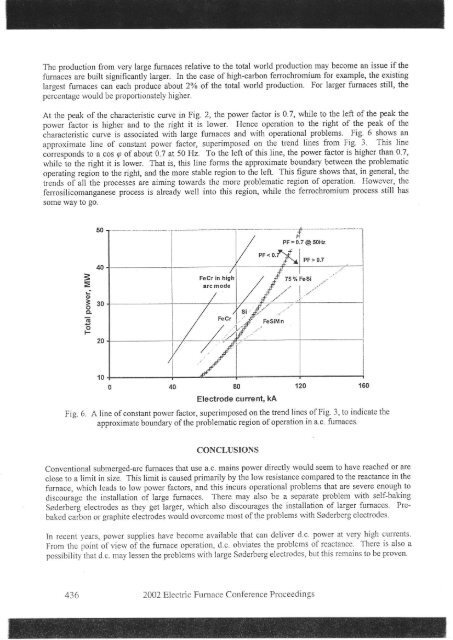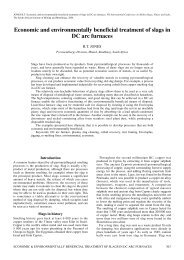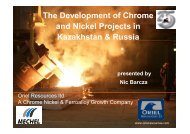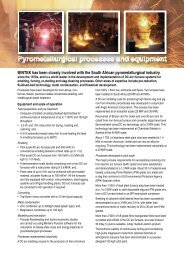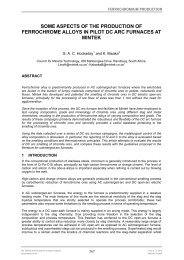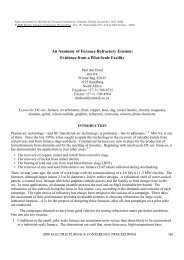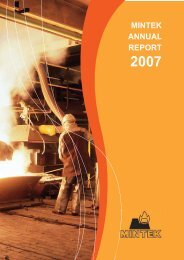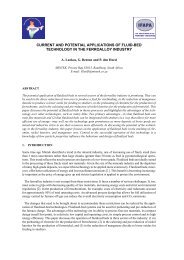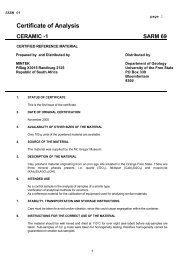the application and scale-up of ac and dc smelting furnaces ... - Mintek
the application and scale-up of ac and dc smelting furnaces ... - Mintek
the application and scale-up of ac and dc smelting furnaces ... - Mintek
Create successful ePaper yourself
Turn your PDF publications into a flip-book with our unique Google optimized e-Paper software.
The production from very large furn<strong>ac</strong>es relative to <strong>the</strong> total world production may become an issue if <strong>the</strong>fum<strong>ac</strong>es are built significantly larger. ln <strong>the</strong> case <strong>of</strong> high-carbon ferrochromium for example, <strong>the</strong> existinglargest fum<strong>ac</strong>es can e<strong>ac</strong>h produce about 2o/o <strong>of</strong> <strong>the</strong> total world production. For larger furn<strong>ac</strong>es still, <strong>the</strong>percentage would be proporlionately higher.At <strong>the</strong> peak <strong>of</strong> <strong>the</strong> char<strong>ac</strong>teristic curve in Fig. 2, <strong>the</strong> power f<strong>ac</strong>tor is 0.7, while to <strong>the</strong> left <strong>of</strong> <strong>the</strong> peak <strong>the</strong>power f<strong>ac</strong>tor is higlrer <strong>and</strong> to <strong>the</strong> right it is lower. Hence operation to <strong>the</strong> right <strong>of</strong> <strong>the</strong> peak <strong>of</strong> <strong>the</strong>thar<strong>ac</strong>teristic cuwe is associated with large fum<strong>ac</strong>es <strong>and</strong> with operational problems. Fig. 6 shows anapproximate line <strong>of</strong> constant power f<strong>ac</strong>tor, s<strong>up</strong>erimposed on <strong>the</strong> trend lines fiom Fig. 3. This lineconesponds to a cos g <strong>of</strong> about 0.7 at 50 tIz- To <strong>the</strong> left <strong>of</strong> this line, <strong>the</strong> power f<strong>ac</strong>tor is higher than 0.7,while to <strong>the</strong> right it is lower. That is, this line forms <strong>the</strong> approximate boundary between <strong>the</strong> problematicoperating region to <strong>the</strong> right, <strong>and</strong> <strong>the</strong> more stable region to <strong>the</strong> left. This figure shows that, in general, <strong>the</strong>trinds <strong>of</strong> all <strong>the</strong> processes are aiming towards <strong>the</strong> more problematic region <strong>of</strong> operation. However, <strong>the</strong>ferrosilicomanganese process is already well into this region, while <strong>the</strong> ferrochromium process still hassome way to go.= ooFecr in higharc inodeEFElectrode current, kAFig. 6. A line <strong>of</strong>constant power f<strong>ac</strong>tor, s<strong>up</strong>erimposed on <strong>the</strong> trend lines <strong>of</strong>Fig. 3, to indicate <strong>the</strong>approximate boundary <strong>of</strong><strong>the</strong> problematic region <strong>of</strong>operation in a.c. fum<strong>ac</strong>es120CONCLUSIONSConventional submerged-arc fum<strong>ac</strong>es that use a.c. mains power directly would seem to have re<strong>ac</strong>hed or areclose to a limit in size. This limit is caused primarily by <strong>the</strong> low resistance compared to <strong>the</strong> re<strong>ac</strong>tance in <strong>the</strong>fum<strong>ac</strong>e, which leads to low power f<strong>ac</strong>tors, <strong>and</strong> this incurs operational problems that are severe enough todiscourage <strong>the</strong> installation <strong>of</strong> large fum<strong>ac</strong>es. There may also be a separate problem rvith self-bakingSoderberg electrodes as <strong>the</strong>y get larger, which also discourages <strong>the</strong> installation <strong>of</strong> larger fum<strong>ac</strong>es. Prebake<strong>dc</strong>arbon or graphite electrodes *'ould overcome most <strong>of</strong><strong>the</strong> problems with Soderberg electrodes.In recant ).ears, power s<strong>up</strong>plies have become available that can deliver d.c. power at very high crmentsFrom <strong>the</strong> point <strong>of</strong> view <strong>of</strong> <strong>the</strong> fum<strong>ac</strong>e operation, d.c. obviates <strong>the</strong> problems <strong>of</strong> re<strong>ac</strong>tance. There is also apossibilitythat d.c. may lessen <strong>the</strong> problems with large Soderberg electrodes, but this remains to be proven436 2002 Electric Fum<strong>ac</strong>e Conference Proceedings


